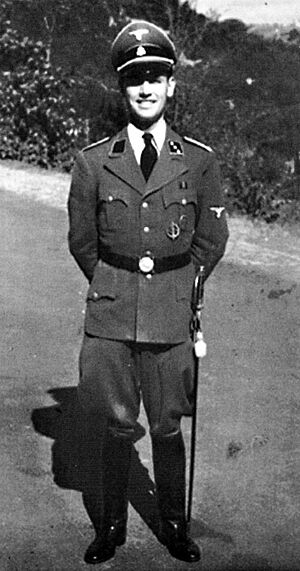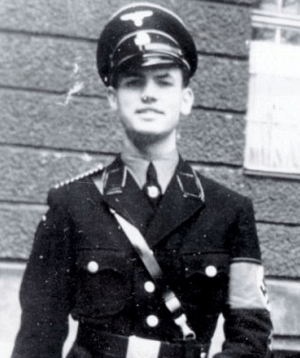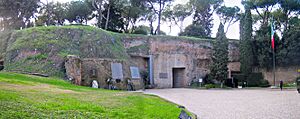Erich Priebke facts for kids
Quick facts for kids
Erich Priebke
|
|
|---|---|

Priebke on duty, 1940s
|
|
| Born | 29 July 1913 Hennigsdorf, German Empire |
| Died | 11 October 2013 (aged 100) Rome, Italy |
| Allegiance | Nazi Germany |
| Service/ |
Schutzstaffel |
| Rank | Hauptsturmführer |
| Unit |
|
Erich Priebke (born July 29, 1913 – died October 11, 2013) was a German officer in the SS, a powerful organization in Nazi Germany. He was found guilty of war crimes in Italy. In 1944, he was involved in the Ardeatine massacre in Rome. This event saw 335 Italian civilians killed. It was done as a punishment after a bomb attack by Italian resistance fighters killed 33 German soldiers. Priebke was one of the people responsible for this mass killing. After World War II ended, he escaped to Argentina. He lived there for nearly 50 years. In 1994, his role in the massacre was revealed by a TV reporter. This led to his return to Italy and a trial that lasted several years.
Contents
Early Life
Erich Priebke was born on July 29, 1913, in Hennigsdorf, Germany. Not much is known about his early life. Priebke said his parents died when he was young. He was mostly raised by an uncle. Later, he worked as a waiter in different cities, including Berlin and London.
Priebke married Alicia Stoll. They had two sons named Jorge and Ingo.
Service in the SS
From 1936, Priebke worked for the Waffen-SS. This was the fighting branch of the SS. Later, he worked for the Gestapo, which was the secret police of Nazi Germany. Because he knew Italian, he was sent to Rome in 1941. There, he worked under another officer named Herbert Kappler.
The Ardeatine Caves Massacre
The Ardeatine Caves massacre happened in Italy during World War II. On March 23, 1944, Italian resistance fighters attacked German soldiers in Rome. They set off a bomb and used guns and grenades. This attack killed 33 German soldiers. The attack was led by a group called the Patriotic Action Groups.
In response, Adolf Hitler reportedly ordered a harsh punishment. He wanted ten Italians killed for every German soldier who died. Commander Kappler in Rome quickly made a list of 320 prisoners to be killed. When a 33rd German soldier died from the attack, Kappler added ten more names to the list. In total, 335 people were killed at the Ardeatine Caves. Most of them were Italian civilians. Many of those killed were members of different resistance groups.
On March 24, SS officers Priebke and Karl Hass led the killings. The victims were taken into the Ardeatine caves in groups of five. Their hands were tied behind their backs. Then, they were shot in the neck. Some people were forced to kneel over the bodies of those already killed. During the killings, a mistake was found. Five extra people who were not on the original list were brought to the caves. Priebke was in charge of the list. His involvement in these five extra killings meant he was personally responsible. This was a key point in his later trial.
To meet the number of people to be killed, many prisoners were taken from jails. Priebke put some people on the list just because they were Jewish. He said he never sent Jews to concentration camps because the trains were needed for other things.
Some of the prisoners were simply people who lived near the bombing site. Others had been arrested and tortured for being part of the resistance. The scale of this retaliation was very unusual.
After the War
Escape to Argentina
After World War II, Priebke was supposed to be tried for his role in the massacre. But he escaped from a British prison camp in Italy in 1946. He later said he was helped by a network that helped Nazis escape, called a "ratline." After escaping, he lived in Italy for a while. He even got a new identity. Then, he went to Argentina. Priebke lived freely in the town of Bariloche for 50 years, even though he was accused of war crimes.
In March 1994, a team from ABC News found Priebke in Bariloche. They learned about his involvement in the Ardeatine massacre from a local book. The book named Priebke as part of a group of Nazis living in Bariloche.
The ABC News team searched old records in many countries. They found documents showing Priebke's background and his role with the Gestapo in Italy. They even found a confession he wrote after the war. In it, he confirmed his part in the massacre. Another document suggested Priebke approved the transport of Italian Jews to death camps. The ABC team watched Priebke's daily life. In April 1994, reporter Sam Donaldson went to Bariloche to interview Priebke.
Donaldson and his team waited for Priebke outside the school where he worked. They interviewed him in his car. Priebke admitted who he was and spoke openly about his role. He said he was just following orders from his commander, Herbert Kappler. He also claimed the victims were "terrorists." He denied that any children were killed. However, three children as young as 14 were among the dead. He admitted that he was the one who made the lists of people to be executed.
Priebke's Extradition
Donaldson's news report showed how freely Priebke lived in Argentina. It also showed that he felt little regret for his actions. Argentinian authorities arrested Priebke. Because he was old and not well, he was held under house arrest at his home.
Priebke's lawyers caused many delays in his extradition. They asked for all Italian documents to be translated into Spanish, which would take a long time. The Argentinian court eventually said no to this. But appeals and other delays made the extradition case last over a year. His lawyers argued that the crime was too old to be prosecuted under Argentinian law.
In March 1995, the Argentinian president promised that Priebke would be sent to Italy soon. But the Supreme Court of Argentina decided the case should go back to a local court. This could have caused years of more delays.
In May 1995, an Argentinian judge agreed to send Priebke to Italy. The judge said that cases of crimes against humanity do not expire. But there were more appeals.
In August of that year, a court ruled that Priebke should not be extradited because the case had expired. To put pressure on Argentina, Germany asked for his extradition the same day. Italian lawyers argued that international agreements say war crimes and crimes against humanity do not expire.
After 17 months of delays, the Argentinian supreme court decided that Priebke should be sent to Italy in 1996. He was flown directly to a military airport near the Ardeatine caves, where the killings had happened.
Trials
Priebke in Court
In court, Priebke said he was not guilty. He did not deny what he had done. But he said he had no moral responsibility. He blamed the massacre on the "Italian terrorists" who attacked the German soldiers. He said the order came directly from Hitler and was a fair punishment. During the trial, it became clear that Priebke had personally shot two Italians. He had also said this in his testimony in 1946 before he escaped.
On March 24, 1944, 335 men went to the Ardeatine Caves. Their hands were tied. Their names were read aloud. They went into the caves in groups of five. Priebke went inside with one of the first groups. He shot a man with a machine pistol. Near the end, he shot another man with the same gun. The killings finished before dark. After the shootings, explosives were used to close the caves. At first, Priebke was found not guilty because he claimed he was following orders.
On August 1, 1996, orders were given to release Priebke. This caused strong reactions from the victims' families. They felt the judges did not value human lives. Protesters blocked the courts for hours.
Appeals
Prosecutors appealed the decision. The next day, Germany asked Italy to keep Priebke in prison. Germany wanted to try him for the two murders he personally committed. There were protests outside the courthouse. But when people learned Priebke had been rearrested, the protests calmed down. Many people visited the Ardeatine Caves to honor the victims.
The Italian Supreme Court said the court that freed Priebke had made a mistake. The appeal went through. It was questioned why the example of the Nuremberg trials was not used earlier. The Nuremberg trials had shown that individuals are responsible for their own actions. Priebke claimed he would have been killed if he had not obeyed orders. But the appeals court did not accept this excuse. The court ordered a new trial for Priebke. He was sentenced to 15 years. This was reduced to 10 years because of his age and health. In March 1998, he was sentenced to life imprisonment, along with Karl Hass, another former SS member. This decision was confirmed later that year. Because of his age, Priebke was put under house arrest.
Priebke's Further Appeals
Priebke continued to appeal his case. He claimed he had no choice but to obey Hitler's orders. This defense was not accepted during the Nuremberg trials. Also, in the Ardeatine Caves massacre, 335 people died. This was five more than the order of "ten Italians for each German killed." These five extra victims were Priebke's responsibility. He was in charge of checking the list.
In 2007, Priebke was allowed to leave his home to work at his lawyer's office. This caused angry protests, and the judge's decision was changed.
Death
Priebke died in Rome on October 11, 2013, at 100 years old. His last wish was to be buried next to his wife in Argentina. But the Argentinian government said no. The Catholic Church in Rome also banned his funeral from being held in any of its churches. His hometown in Germany also refused his body. They feared his burial place could become a site for neo-Nazis to visit.
A priest offered to hold the funeral ceremony for Erich Priebke in another city. During the funeral, police had to stop clashes between people who supported Priebke and those who were against him. The funeral happened without his family present. They could not enter the city because of the riots.
Eventually, Priebke's coffin was taken by Italian authorities. It was moved to a military base near Rome. Then, he was buried in a "secret location." His lawyer said this agreement met the family's wishes.



